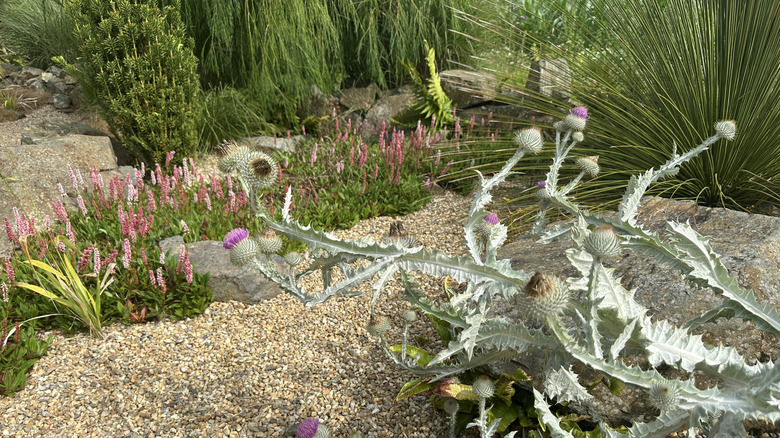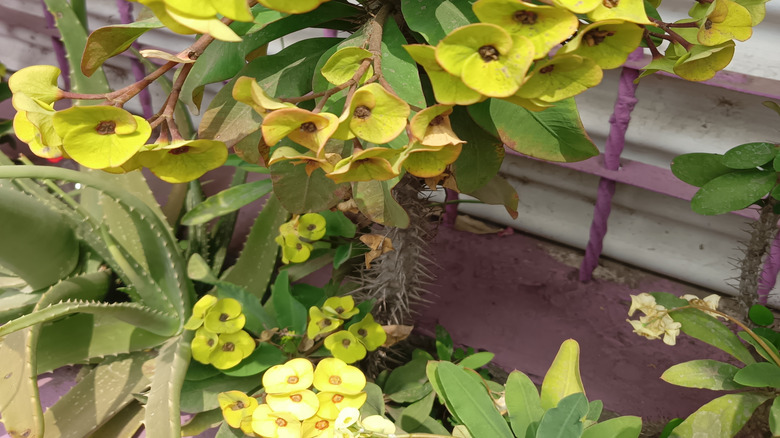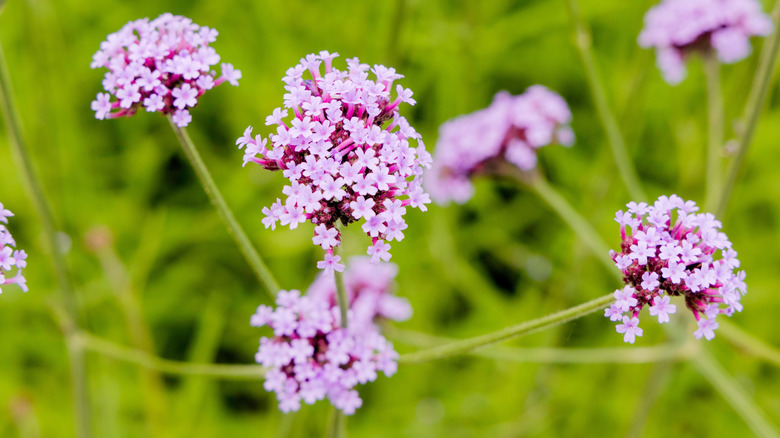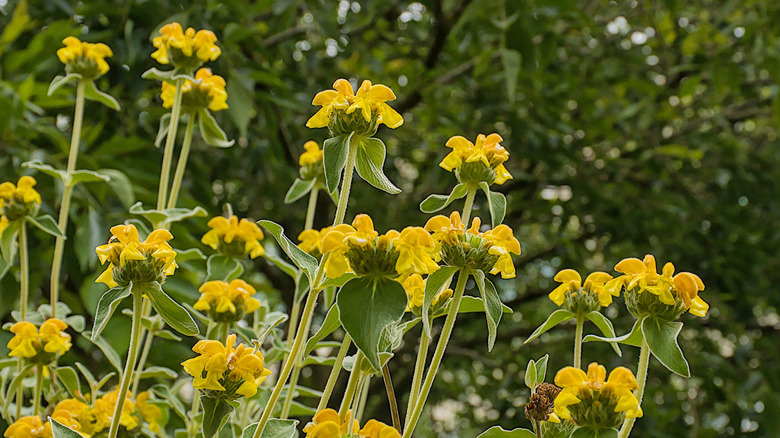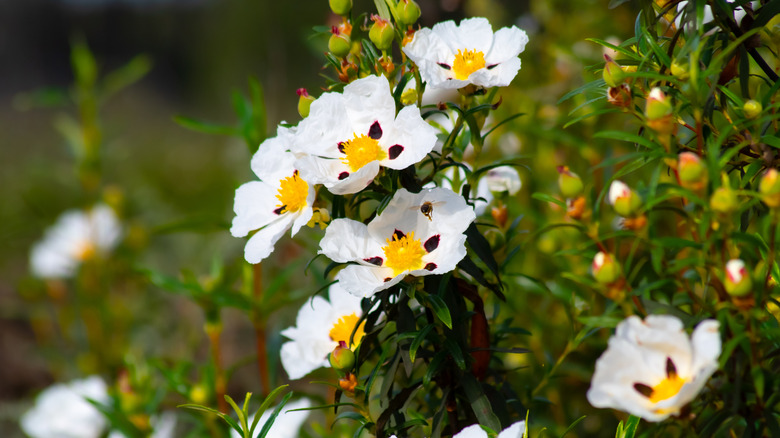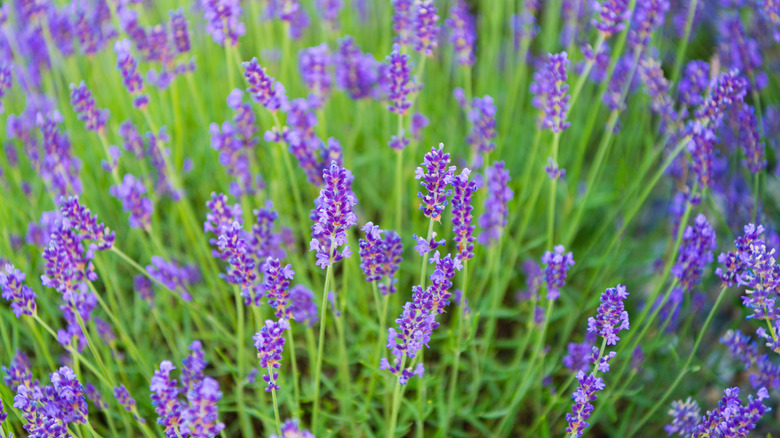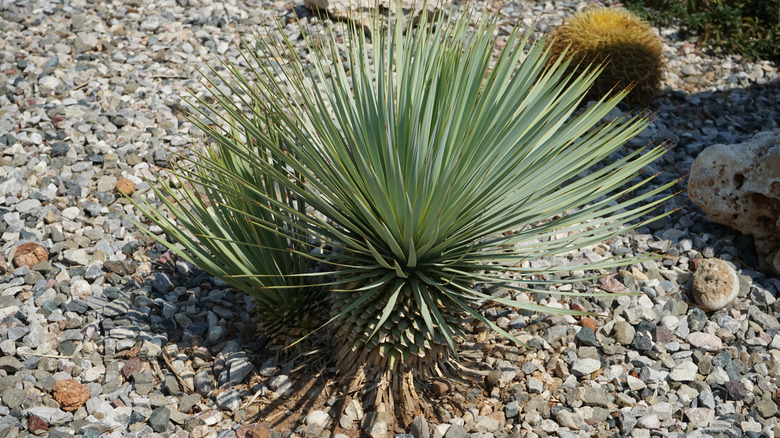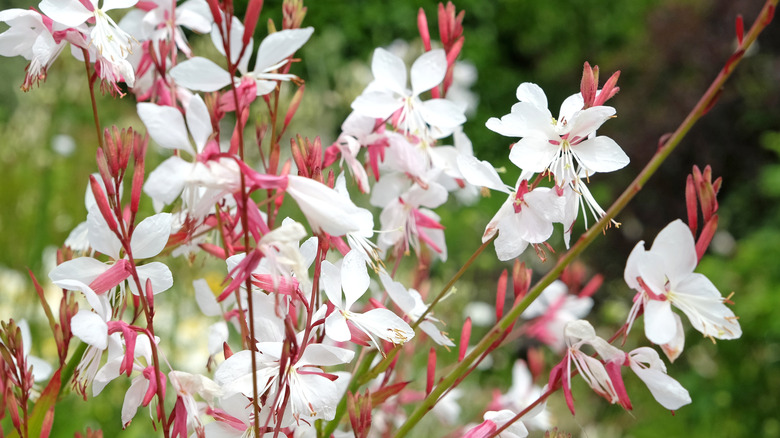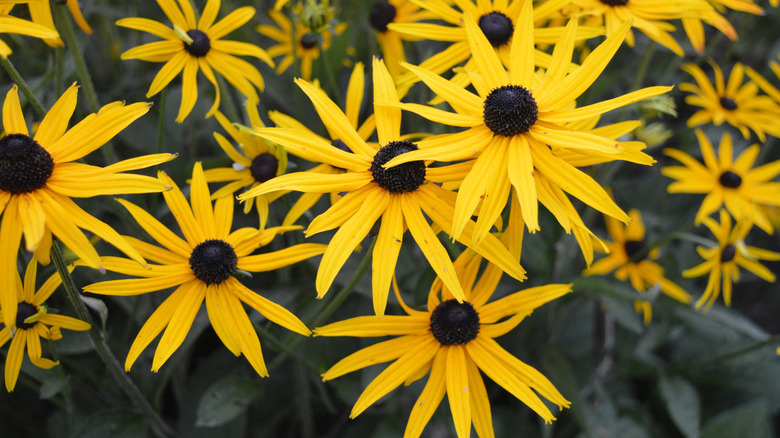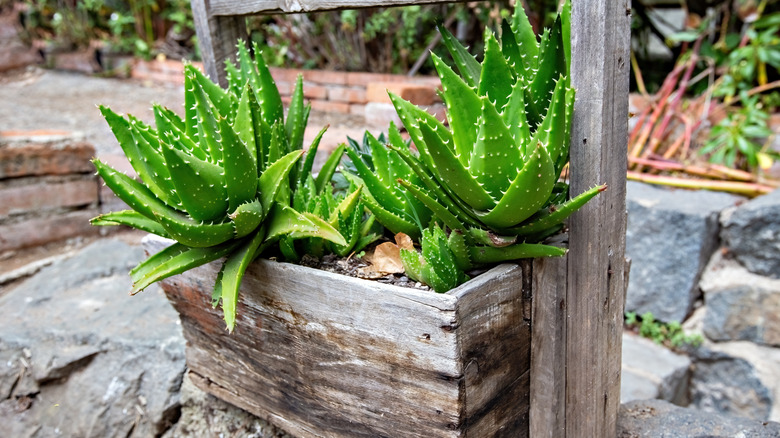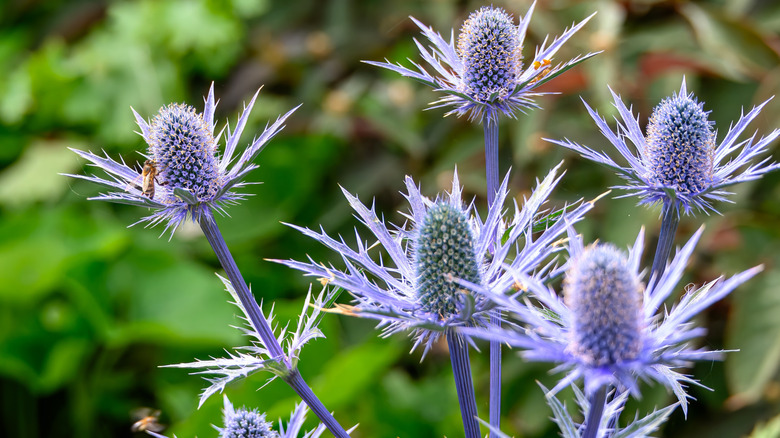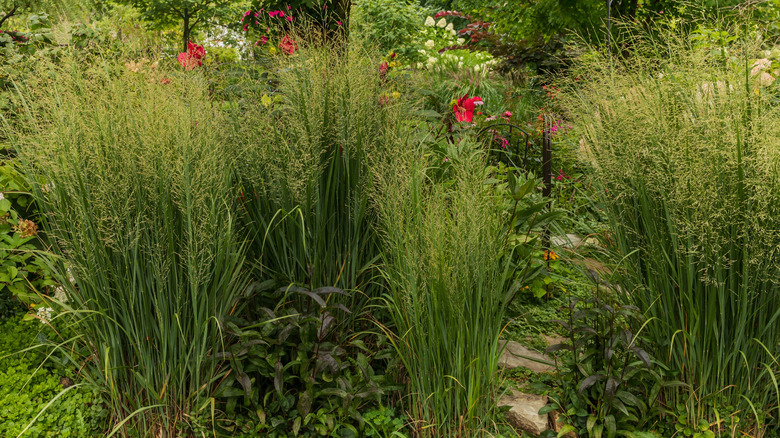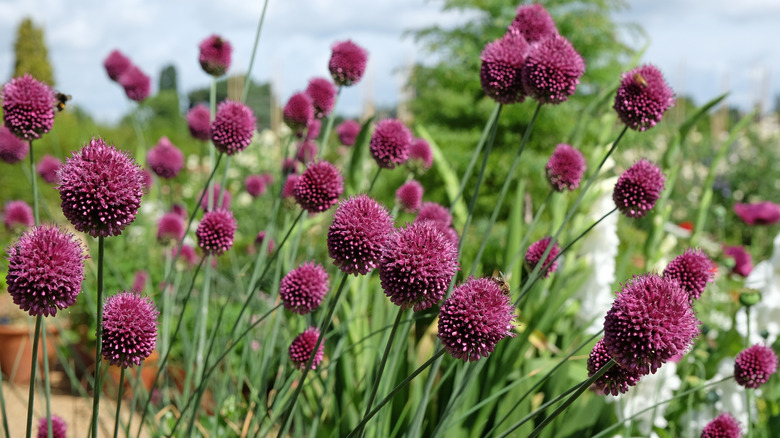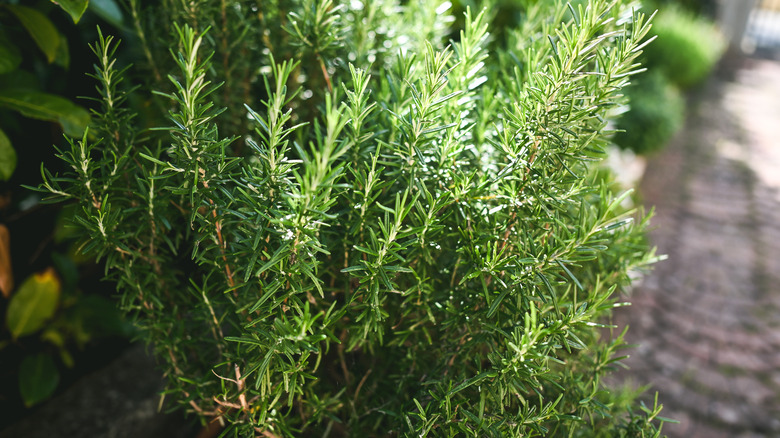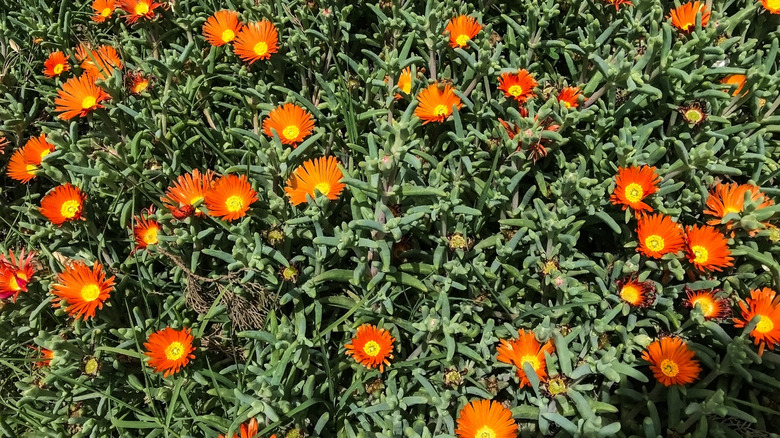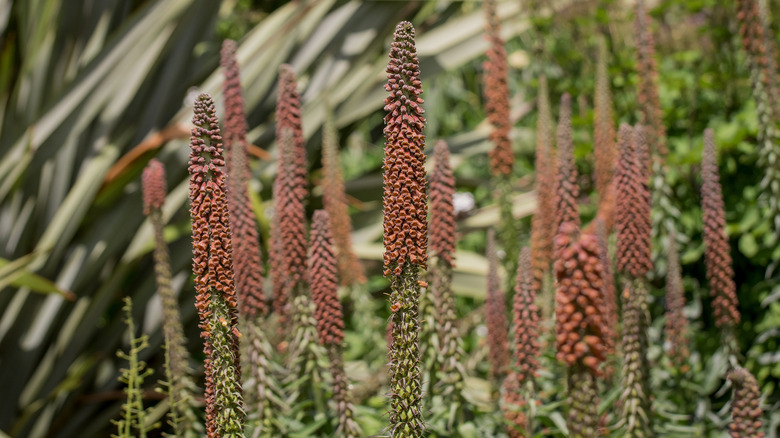15 Perennial Plants That Grow Well In Gravel Landscapes
If you're looking to create areas in your yard that look great, are unique, and don't require a lot of upkeep, consider adding a gravel garden or two. Many homeowners are turning to gravel gardens to save water and enjoy less yard work, as gravel gardens don't need as much maintenance as traditional garden beds require. The possibilities are endless, allowing you to create an area that is not only stunning but inviting too. The following 16 perennials are ideal candidates because they love the same growing conditions that are present in gravel gardens. These include excellent drainage, plenty of sunshine, and a drier environment with less frequent watering.
For the best success in growing these perennials in a gravel garden, prepare the soil that will be under the gravel by digging down 5 inches, adding quality compost, and mixing it well so your plants can get the necessary nutrients and moisture. This is especially beneficial in hot, dry regions and during the summer months when temperatures are high. To create interest and visual appeal, you can include one or more top gravel types, like pea gravel and Jersey shore gravel, in your garden. These gravel garden ideas will transform your outdoor space and provide a place you can enjoy for years to come.
Creeping spurge
Creeping spurge (Euphorbia myrsinites) is a perennial succulent that is hardy in USDA Hardiness Zones 4 to 8. Creeping spurge has a bit of a reputation in several Western states, where it is an invasive or noxious weed, including California, Oregon, Washington, Utah, and New Mexico. If you live in that region, it's best to choose another perennial. In other parts of the U.S., it is fine to plant and makes a great addition to a gravel garden. Creeping spurge thrives best in dry, well-drained soils, including poor and rocky soils, and loves full sun. The milky sap is poisonous if ingested and can cause skin irritation.
Tall verbena
Tall verbena (Verbena bonariensis), also called purple top verbena, is a lovely purple-flowered perennial hardy in zones 7 to 11. It tolerates many different soil types and average to drier conditions. It thrives in full sun, and once established, you won't need to water it unless there is an extended drought period. Tall verbena does better when planted in groups along with other flowers. There are a few states where it is invasive, including California, Oregon, and Georgia, and it is sometimes considered a weed. Avoid planting it in those states, and prevent it from spreading into natural areas.
Jerusalem sage
Jerusalem sage (Phlomis fruticosa) is a Mediterranean native that is hardy and evergreen in zones 8 to 10. In zones 5 to 7, the plant will die back to the ground during the winter, but the roots typically survive. Jerusalem sage thrives in full sun and does best in medium moisture, but tolerates dry soil. This sunny flower attracts hummingbirds and butterflies and has seed heads that can be left for other birds to nibble on. If you cut the stems back after the flowers bloom, you can get another round of flowers.
Crimson-spot rockrose
Crimson-spot rockrose (Cistus ladanifer) is a flashy perennial that features white flowers up to 4 inches wide. At the base of each petal, there is a crimson spot, providing a unique look that looks wonderful in a gravel garden. This eye-catching plant is hardy in zones 7 to 10. It thrives in full sunlight and can handle a variety of soil types, including sandy or rocky. It tolerates dry conditions well and needs well-draining soil to prevent root rot.
Lavender
Lavender (Lavandula angustifolia) is a wonderfully fragrant perennial hardy in zones 5 to 10. It is a favorite of pollinators of all kinds, including bees, butterflies, and hummingbirds. Lavender grows beautifully in full sun and well-draining soil. It does great in dry conditions but will not thrive in soaked soil or standing water. It's often used in drink and food recipes, as well as in essential oil form to reduce anxiety. As beautiful and fragrant as lavender is, it is toxic to cats, dogs, and horses.
Yucca rostrata
Yucca rostrata is a slow-growing, evergreen perennial featuring an abundance of leaves that are around 2 feet long. These leaves are a lovely blue-green color, and there are usually hundreds of them on a single plant. Yucca rostrata thrives in full sun but can tolerate some shade as long as it gets at least three hours of sunlight daily. It is hardy in zones 5 to 12 and prefers dry soil. It only has to be watered about every two or three weeks when the soil is completely dry. Overwatering Yucca rostrata can lead to root rot.
White gaura
White gaura (Oenothera lindheimeri) is an herbaceous perennial featuring white blooms that fade to pink. This pretty plant is hardy in zones 5 to 9 and is resistant to heat and drought, making it an ideal addition to your gravel garden. It thrives in full sun, with at least 6 hours of direct sunlight being the best. It can grow in a range of soils, including sandy soil. Well-draining soil is a must, or root rot may develop. Powdery mildew can also become a problem in poorly draining soil.
Black-eyed Susan
Black-eyed Susan (Rudbeckia fulgida) is a brightly-colored perennial that is loved by bees and butterflies and blooms from June all the way to September or beyond. Black-eyed Susans are hardy in zones 3 to 9 and grow to be 2 to 3 feet tall. The bright yellow flowers and brown centers are 1 to 3 inches in diameter. These happy flowers are ideal in gravel gardens, as they thrive in full sunlight with at least six hours per day. Black-eyed Susans prefer shallow, rocky, or clay soils that have excellent drainage and are drier.
Aloe vera
Aloe vera is a useful perennial native to Africa that grows 2 to 3 feet tall and up to 2 1/2 feet wide. Most people are familiar with this plant as a remedy for burns. Although the gel is safe for use on the skin, the leaves are toxic to people, cats, dogs, and horses if ingested. Aloe vera is hardy in zones 8 to 11 and thrives in hot, dry conditions, preferring full sunlight and well-draining soil with infrequent water. Aloe vera plants grown outdoors year-round are likely to bloom when they get full sun daily.
Sea holly
Sea holly (Eryngium planum) plants feature striking silver or blue-tinted flowers that resemble thistles, making them lovely ornamental perennials for gravel gardens. They're hardy in zones 5 to 9. They thrive in full sun, and well-draining soil is critical, or they can get root rot and die. You can protect the roots of this unique plant with straw mulch to get it through the winter.
Switch grass
Grasses always add a nice accent to gravel gardens, like switch grass (Panicum virgatum). This ornamental, perennial grass is native to North Carolina but can be found all over North America. Switch grass is hardy in zones 5 to 9 and grows best in full sun. It can handle a variety of soil moisture levels, from dry to wet. It is very adaptable, making it ideal for gravel gardens. Switch grass is also a great plant for wildlife, as it's a source of shelter and seeds for many different species.
Drumstick allium
Drumstick allium (Allium sphaerocephalon) features gray-green foliage and rose-purple egg-shaped flowers that add color and uniqueness to gravel gardens. It's hardy in zones 4 to 8 and grows best in at least six hours of direct sunlight daily. This striking plant can easily grow well in rocky or sandy soil. A neutral pH and well-draining soil provide the best growing conditions for drumstick allium. Though it is in the onion family, it is toxic if ingested.
Rosemary
zones 8 to 10 is a hardy perennial herb that is part of the mint family. This well-known herb looks like a rounded shrub featuring gray-green leaves shaped like little needles. In the spring and summer, rosemary produces tiny white and blue flowers. Rosemary thrives in full sun. It is hardy in zones 8 to 10, though some varieties can handle lower zones. Dry soil is preferred; it needs to be watered every one and a half to two weeks, when the soil is dry to the touch, 1 inch from the top.
Ice plant
Orange ice plant (Lampranthus aurantiacus) is a native of Africa and thrives in hot conditions. This brightly colored succulent can grow several feet wide. The gray-green leaves are complemented by brilliant orange blooms with bright yellow centers. Orange ice plant is hardy in zones 9 to 11 and prefers well-draining soil that can be rocky, sandy, or loam. It needs at least six hours of daily sun for the best growing results, but more is just fine as well.
Small-flowered foxglove
Small-flowered foxglove (Digitalis parviflora) is a slim, unique-looking perennial that is hardy in zones 4 to 8. It does well in both sun and shade. This plant adapts to a variety of soil types, including chalk, clay, sand, and loam, as long as they drain well, and does great in gravel gardens. With its towers of tubular bronze-brown flowers, it attracts a number of pollinators, including birds and bees. Foxglove is toxic to cats, horses, and dogs.
